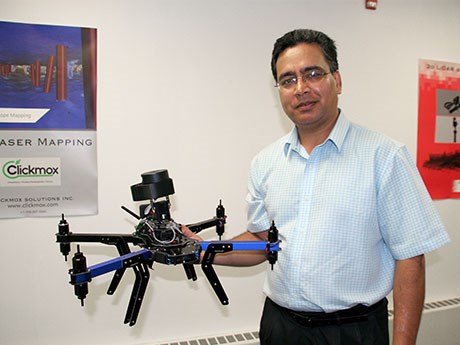3D laser equipped drone identifies location of ore pass blockages
One of the challenges in underground mining is knowing the precise point in space or location of things: for example, mobile equipment, personnel, ore pass blockages and pillars.
Knowing where mobile equipment and personnel are is important for ventilation-on-demand, as well as for safety.
Having the precise location of an ore pass obstruction is necessary in order to clear it, and having data on slight changes in the width of a drift or movement of ground is important to prevent the collapse of pillars.
RFID technology is currently used in the industry for tracking equipment and personnel, and other methodologies are used for discerning ground movement, but there’s another more powerful and more precise technology from the realm of robotics that Sudbury startup Clickmox Inc. is applying to the mining industry. It’s called Simultaneous Localization and Mapping, or SLAM, for short.
SLAM was developed to allow robots to navigate despite not having any prior knowledge of the environment in which they find themselves, explained Clickmox president Syed Naeem Ahmed.
“The robot moves a step forward, creates a map and matches it with a map that it generated in the last instance, so without any prior knowledge of the environment, you can just go in, do a scan, and get all the x, y and z co-ordinates. Then, all you do is orient that point cloud with respect to the mine co-ordinate system, which is pretty straight-forward.”
RFID only provides an approximate location of equipment and personnel because it has to communicate with readers that are spaced out in a mine. “It doesn’t tell you where the machine is. At best, it tells you it’s somewhere within a range of 200 to 500 metres,” said Ahmed.
“What we are developing is a positioning system that will tell us precisely where a machine is. It’s based on laser mapping technology. It will have a 3D map of the whole mine in memory and as the machine is moving through the drift, it does pattern recognition to figure out where it is with respect to that map. It sends the information through the leaky feeder system to surface, where there is also a 3D map of the mine. That’s how they will know where the machine is.”
More precise information about the location of equipment and personnel will help to optimize ventilation-on-demand systems.
The technology can also be used to do convergence monitoring.
“Pillars and drifts sometimes start to bulk and collapse,” said Ahmed. “It’s a serious safety issue. Now, they send people down with flashlights to look at what’s going on. If they find an area that they suspect could be a problem, they use a tape measure that they call an extensometer to measure the width of a drift at different points, then compare it with previous numbers. It’s very labour-intensive, disruptive and not very reliable.”
Precisely determining the location of an ore pass blockage is one problem the mining industry hasn’t been able to solve.
“Finding where the clog is from the bottom is very difficult,” said Ahmed. “It’s easier from the top. They can drop something down, use a laser scanner or a video camera, but you have to know from both ends. They have tried everything, and nothing has worked.
“I was talking to some of the engineers at Vale and they said, ‘Why don’t you use drones. Fly a drone up with a laser and a video camera and it will tell us exactly where the blockage is.’
“Drone technology is very well developed. The missing part was the laser scanner because all the 3D laser scanners that are currently available are $60,000 to $70,000,” said Ahmed.
Subjecting a $10,000 drone with a $60,000 to $70,000 scanner to the perilous environment of a blocked ore pass that could give way at any moment was a nonstarter, so Ahmed set his sights on bringing the cost down to a maximum of $15,000 for the whole package.
“I talked to Vale, Glencore and Goldcorp and they’re very interested. I was in Red Lake earlier this year and they’re looking for a drone they can use in ore passes and stopes.
“It’s a safety issue,” said Ahmed. “You can’t send people too close because you never know when it will give way.”
A prototype of a Clickmox drone with a laser scanner and video camera will be ready for the Extemin trade show in Arequipa, Peru September 21 to 25.
Ahmed’s introduction to the mining industry came by way of an employment opportunity at the Sudbury Neutrino Observatory, or SNOLAB, an underground laboratory specializing in neutrino and dark matter physics two kilometres underground at Vale’s Creighton Mine.
A PhD in Physics, Ahmed worked at the Max Planck Institute in Germany and the Fermi Lab in Chicago – both world-renowned physics research institutions – prior to coming to Sudbury. When the experiment he was working on at the SNOLAB concluded after five and a half years, Ahmed joined Penguin Automated Systems Inc., a Sudbury company specializing in robotics. He was subsequently recruited by Mining Technologies International to head up an automation and robotics program, but was handed a pink slip when the company ran into financial problems.
Thinking it was time to start something himself, Ahmed founded Clickmox in February 2014.
“The industry is now realizing that without robotics and automation, it will be extremely difficult to remain competitive,” he said. “Productivity in the mining industry has been going down for quite some time. For lateral development, we were at 20 to 22 feet per shift 20 years ago. Now, we’re down to seven, eight or 10 feet per shift. Mining companies need to invest in new technology to bring that up again and stay in business.”
Applying robotics technology to equipment and personnel tracking, convergence monitoring and clearing ore pass blockages is a good start. Where the technology goes from there is anyone’s guess.
clickmox.com


